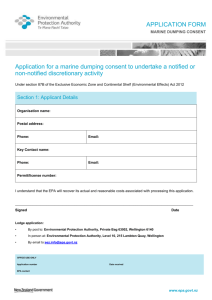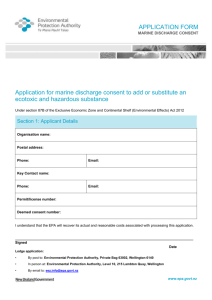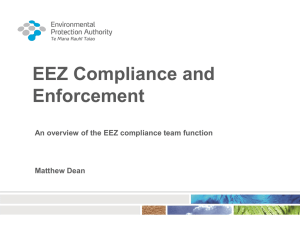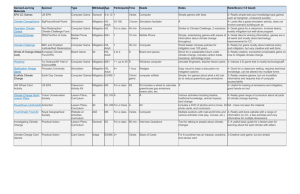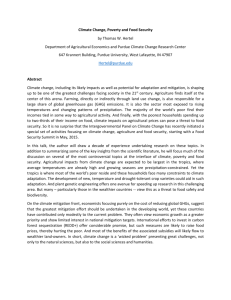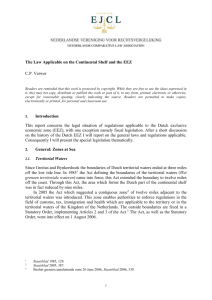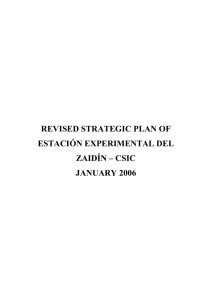Approach to Impact Assessment - Environmental Protection Authority
advertisement
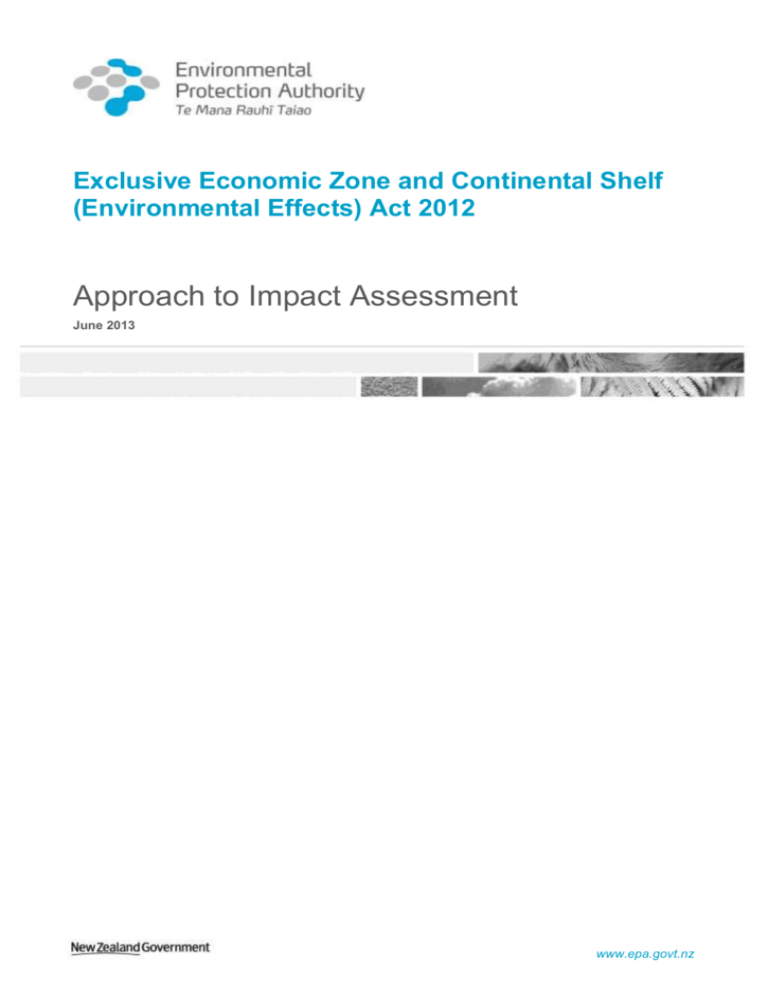
Exclusive Economic Zone and Continental Shelf (Environmental Effects) Act 2012 Approach to Impact Assessment June 2013 www.epa.govt.nz 2 Approach to Impact Assessment Table of Contents Purpose................................................................................................................................................... 3 Structure and content of your Impact Assessment ........................................................................... 3 Qualities of a good Impact Assessment ............................................................................................. 4 Scoping and Impact Assessment Terms of Reference ..................................................................... 5 Consideration of alternatives ............................................................................................................... 5 Non-Technical Summary....................................................................................................................... 6 Identifying and characterising effects ................................................................................................. 6 Clear methodology ................................................................................................................................ 7 Cumulative and synergistic effects ..................................................................................................... 7 Avoiding, remedying and mitigating adverse effects on the environment and existing interests 7 Conditions .............................................................................................................................................. 9 Environmental Management Plans (EMPs) ......................................................................................... 9 Where can I get more information? ................................................................................................... 10 June 2013 – EPA0257 3 Approach to Impact Assessment Purpose 1. This guideline outlines our approach to Impact Assessment, which may be used when you are preparing an Impact Assessment for activities in the Exclusive Economic Zone and Continental Shelf (EEZ), as required by the Exclusive Economic Zone and Continental Shelf (Environmental Effects) Act 2012 (EEZ Act). We strongly recommend that you use this guidance note to assist in preparing your Impact Assessment. 2. An application for a marine consent must be accompanied by an Impact Assessment (IA), prepared in accordance with Section 39 of the EEZ Act. Find detailed guidance about the content and process for marine consent applications http://www.epa.govt.nz/EEZ/working_eez/Pages/making_marine_consent_application.aspx 3. Existing or planned petroleum activities regarding transitional provisions for alteration or new activities under sections 162 or 166 of the EEZ Act must also prepare an impact assessment for our acceptance. Find guidance about the transitional provisions of the EEZ at http://www.epa.govt.nz/EEZ/working_eez/Pages/eez_transitional_provisions.aspx 4. As a person operating or proposing to operate in the EEZ or on the continental shelf, you have a general duty (section 25) to avoid, remedy or mitigate the effects of activities on the environment and existing interests. Section 39 of the EEZ Act requires you to identify the measures you intend taking to avoid, remedy or mitigate adverse effects on the environment and existing interests. 5. In addition to considering how adverse effects should be avoided, remedied or mitigated, you should also consider opportunities to enhance the environment that may arise as a result of your proposal. In some cases this can occur alongside compensatory action, but the two should not be confused. Structure and content of your Impact Assessment 6. Your Impact Assessment must: be prepared at a level of appropriate detail for the scale and significance of the effects your activity may have on the environment or existing interests, and be in sufficient detail to enable us and people with existing interests to understand the nature of your proposal and the effects it may have on the environment and existing interests. 7. In accordance with section 39 of the EEZ Act, your Impact Assessment must— a) describe the activity for which consent is sought; and b) describe the current state of the area where it is proposed that the activity will be undertaken and the environment surrounding the area; and c) identify the effects of the activity on the environment and existing interests (including cumulative effects) and effects that may occur in New Zealand or in the sea above or beyond the continental shelf beyond the outer limits of the exclusive economic zone; and June 2013 – EPA0257 4 Approach to Impact Assessment d) identify persons whose existing interests are likely to be adversely affected by the activity; and e) describe any consultation undertaken with persons described in paragraph (d) and specify those who have given written approval to the activity; and f) include copies of any written approvals to the activity; and g) specify any possible alternative locations for, or methods for undertaking, the activity that may avoid, remedy, or mitigate any adverse effects; and h) specify the measures that the applicant intends to take to avoid, remedy, or mitigate the adverse effects identified. 8. Section 39 of the EEZ Act sets the minimum requirements for your Impact Assessment. Accordingly, we may request further information to clarify or expand on issues. Such requests will delay the processing of your application. Qualities of a good Impact Assessment 1 9. The list below outlines the qualities of a good Impact Assessment as an effective tool to support decision-making. Further information is provided for bolded bullet points in the paragraphs following this list. A Terms of Reference developed through a scoping process Clear structure, with a logical sequence (as per section 39 of the EEZ Act) Table of contents at the beginning of the document A single document with appropriate cross-referencing Concise, comprehensive and objective text Impartiality without bias or advocacy for a decision Effective use of diagrams, illustrations, photographs and other graphics to support the text Consistent terminology throughout the document with a glossary References for all information sources used Clear explanation of complex issues A good description of the methods used for the studies of each environmental topic Consideration of alternatives A Non-Technical Summary, which does not contain technical jargon Identification of predicted effects, mitigation and residual effects following mitigation (including cumulative and synergistic effects), 1 Adapted from European Commission – Guidance on EIA – EIS Review June 2001 June 2013 – EPA0257 5 Approach to Impact Assessment Uses a clear methodology Considers the effects on environment and existing interests, as appropriate and relevant, of construction, operation, maintenance and decommissioning stages of development Identification of the level of confidence in source information and conclusions about significance of effects Suggests outcome-based conditions and environment commitments, including an Environmental Management Plan, to secure proposed mitigation Articulates industry best practice. Scoping and Impact Assessment Terms of Reference 10. Effective scoping of the Impact Assessment is one of the keys to the delivery of quality Impact Assessment processes and documentation. 11. Your Impact Assessment should be prepared in “such detail as corresponds to the scale and significance of the effects the activity may have on the environment and existing interests” (section 39(2)). Starting preparation of your Impact Assessment with a scoping exercise could help you to meet this requirement, by focusing your assessment. The benefits of scoping include 2: Reduced potential for further information requests after the application has been submitted A platform for a focused and concise Impact Assessment Potential time, cost and resource savings for you and us. The process can act as a vehicle for stakeholder and iwi engagement from the outset of your proposal. Clear intent to address effects fully can be demonstrated, assisting stakeholder and iwi engagement including showing how engagement influenced your Impact Assessment. 12. As part of the scoping exercise, you may consider establishing a Terms of Reference (TOR) for your Impact Assessment, for discussion with us during pre-lodgement. Whilst pre-lodgement discussions are not mandatory, they are recommended as an opportunity for clarifying expectations and information requirements, which can have a beneficial effect on the whole process. 13. Any Terms of Reference should be succinct and targeted, consistent with the scale and detail of your proposal. It would outline the scope of your forthcoming Impact Assessment, and discuss why you scoped in or out potential effects on the environment and existing interests. Consideration of alternatives Institute of Environmental Management and Assessment (2011) Special Report – State of Environmental Impact Assessment Practice in the UK 2 June 2013 – EPA0257 6 Approach to Impact Assessment 14. As part of the Impact Assessment process, section 39 of the EEZ Act requires you to specify any possible alternative locations for, or methods for undertaking your activity that may avoid, remedy, or mitigate any adverse effects. You are not required to invent alternatives; any alternatives should be realistic and capable of implementation. However, if there are no feasible alternatives, you should explain why. Non-Technical Summary 15. The audience for a marine consent application is broad, including the EPA, other marine management regime regulators, iwi and the general public. Providing a Non-Technical Summary (NTS) is good Impact Assessment practice, as it makes the Impact Assessment more accessible to a wider audience. Ideally it should be available separately as well as being included in the Impact Assessment. Maps, diagrams and illustrations should be included. The preferred paper size for a Non-Technical Summary is A4, so it can be easily photocopied. Identifying and characterising effects 16. The effects of your activity on the environment and existing interests (s39(1)(c)) need identification and characterisation. A good practice Impact Assessment identifies predicted effects pre-mitigation, and residual effects post-mitigation. Take a structured and consistent approach across your application, and provide sufficient information and robust evidence to enable us to make our own judgement about the way you identify and characterise effects. 17. In identifying and characterising effects, your Impact Assessment will need to address whether each is: Direct - arising as a result of the proposal itself (e.g. changes in water quality, occupation of the seafloor by structures) Indirect - arising from effects associated with measures required to accommodate the proposal (e.g. discharges from a facility having an effect on human health through the food chain); Secondary/induced - arising from development or induced by the proposal; Short, medium or long term - the duration of effects where short term may be less than one year, medium term one to five years and long term over five years; Permanent or temporary - whether or not change is reversible or irreversible, given mitigation measures, or whether the effect is for a limited duration; Positive or negative - whether the effects are beneficial or detrimental to the environmental resources like fishery stocks or receptors like benthic communities; and Cumulative - arising from the combined effect of a number of effects from this and other activities (inter- and intra-project effects). Uncertainty June 2013 – EPA0257 7 Approach to Impact Assessment 18. Uncertainty is an inherent factor in predicting effects on the environment or existing interests, particularly in the EEZ and continental shelf, because of distances from shore, the lack of existing development, and the three-dimensional fluid nature of the environment. 19. Address uncertainty in your Impact Assessment. State your confidence in the process undertaken and the conclusions you reach. Express the level of confidence in your characterisation of effects. You can use a range from low confidence, whether there is limited data and no expert consensus, to good or very good confidence, whether there is unity between expert views and comprehensive data. For example, you may reach a conclusion of good confidence in an effects characterisation for benthic communities, if you have sound baseline environmental data and the expert(s) you have commissioned can reach a consensus about the likelihood and consequences of a potential effect on those communities. Clear methodology 20. Use a clear methodology in the Impact Assessment to assist the EPA in conducting its completeness check and in reviewing the assessment that you have put forward. Lack of clarity will result in requests for clarification and further information, which will impact on the time the marine consenting process takes. Cumulative and synergistic effects 3 21. An Impact Assessment must identify the full range of environmental effects and effects on existing interests that are likely to result from a proposal, including the project’s indirect or secondary effects. 22. Address cumulative effects in your Impact Assessment, including both intra- and inter-project effects: Intra-project effects occur between different environmental aspects or existing interests within the same proposal, as a result of that development’s direct effects Inter-project effects occur as a result of the likely impacts of the proposal interacting with other developments in the vicinity. You should identify and consider relevant existing developments (mining, petroleum, fishing etc.) and reasonably foreseeable future actions (those that have already gained consent from us or from other marine regulators). Avoiding, remedying and mitigating adverse effects on the environment and existing interests 23. You should identify in your Impact Assessment how the EEZ Act mitigation hierarchy of avoid, remedy or mitigate has been applied. Section 39 of the EEZ Act requires you to identify mitigation from other marine management regimes, for example the Health and Safety in Employment Regulations, which could also result in the mitigation of effects on the environment or existing interests. The mitigation hierarchy is illustrated in Figure 1. Informed by Institute of Environmental Management and Assessment (2011) Special Report – State of Environmental Impact Assessment Practice in the UK 3 June 2013 – EPA0257 8 Approach to Impact Assessment June 2013 – EPA0257 9 Approach to Impact Assessment Figure 1 – Mitigation hierarchy (adapted from IEMA 2011) No effect Enhance Significant Environmental Avoid Remedy Mitigate Conditions 24. There is a strong link between the mitigation for a proposal and any conditions that may be included on a marine consent. Mitigation conditions should be framed as effective, outcome-based conditions. Include draft conditions with your application which demonstrate this. 25. Adaptive management approaches may be part of your mitigation. An adaptive management approach may allow an activity to commence on a smaller scale or for a shorter period than originally requested, while effects on the environment or existing interests are monitored. Adaptive management could include conditions requiring an activity to start in stages, with a requirement for regular monitoring and reporting before the next stage can start. A stage could refer to the duration of the consent, the area over which consent is granted, the scale, intensity or nature of the activity. Environmental Management Plans (EMPs) 26. An EMP is an environmental management tool to ensure that mitigation identified in your Impact Assessment is implemented throughout the stages of your development life-cycle if consent is granted. 27. EMPs detail mitigation for a proposed development. They may also form an integral part of an adaptive management approach. The objectives of an EMP approach include: Ensuring compliance with regulatory requirements and guidelines; Verifying environmental performance through information about impacts as they occur; Responding to changes in implementation not considered in your Impact Assessment; Responding to unforeseen events; and Providing feedback for continual improvement in environmental performance. 28. We support EMP development as a tool for managing effects from your activity. An EMP should: a) Describe relevant environmental performance objectives and standards. b) Describe the relevant activity performance standards you propose to adopt to ensure that mitigation measures identified in your Impact Assessment are undertaken to the level required to mitigate to the residual level of effects June 2013 – EPA0257 10 Approach to Impact Assessment c) Describe the systems, practices and procedures you would adopt to monitor objectives and standards, and manage within them d) Set procedures for regularly assessing the risks (to achievement of objectives and standards) and how you would adjust your activity if these risks increase. Where can I get more information? 29. Please contact us if you need more information: Environmental Protection Authority Level 10, 215 Lambton Quay Private Bag 63002, Waterloo Quay Wellington 6140, New Zealand eez.info@epa.govt.nz 64 4 916 2426 June 2013 – EPA0257
